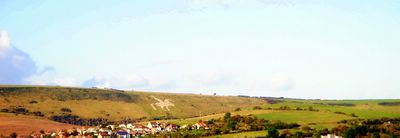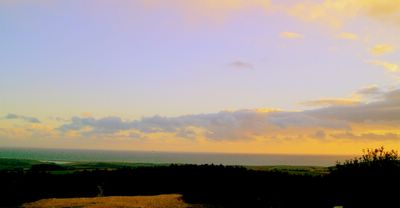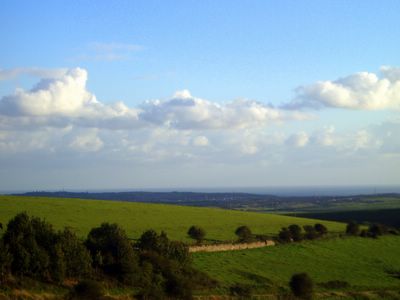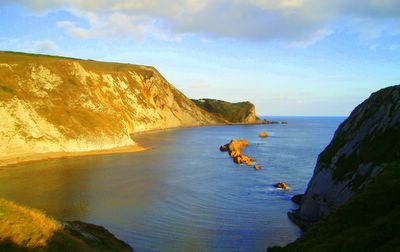
Durdle Door (sometimes spelt Durdle Dor) is a natural limestone arch on the Jurassic Coast near West Lulworth in Dorset, England. The arch has formed on a concordant coastline where bands of rock run parallel to the shoreline. Here the rock strata run near vertical, and the bands of rock are quite narrow. Originally a band of resistant Portland Limestone ran along the shore, the same band which can be seen two miles down the coast forming the narrow entrance to Lulworth Cove. Behind this is a 400 ft (120 metre) band of various weaker rocks which are easily eroded, and behind this is a stronger and much thicker band of chalk, which forms the Purbeck Hills. The limestone and chalk are much closer together here than at Swanage, ten miles to the east, where the distance between them is over two miles. This is because plate tectonics has twisted and folded the rocks forcing the strata vertical here, and this pressure has also compressed the clays. At Durdle bay all except a short stretch of the limestone has been completely eroded away by the sea and the remainder forms a small headland where it has protected the clay behind. At the western end this band of limestone has been eroded through, creating the natural arch. The 400 foot isthmus which joins the limestone to the chalk is made of a 50 metre band of Portland Limestone, which is less resistant than the Portland beds, a narrow and compressed band of Eocine clays, Wealdon Clay, sands and chert beds and then narrow bands of Greensand and sandstone. In Man-of-War bay, the small bay immediately east of Durdle Door the Portland stone has not been entirely eroded away, and at low tide the band of Portland stone is partially revealed. Durdle Door is a popular tourist "honeypot," as it is a short walk from the equally popular Lulworth Cove, and lies on the South West Coast Path. Within walking distance of the car park at Lulworth are these two unique landforms, a fossilised forrest and examples of common rock types from the Jurassic, Triassic and Cretaceous. The area is part of the 95 mile World Heritage Site because of its geology, and these factors make the site one of the most visited natural tourist attractions in the country, with the National Trust estimating the number of hiking journeys across Hambury Tout between Lulworth and Durdle Door as being over a million annually.
Picture © 2004 onwards by Dr Sanjukta Acharya. All the photographs in this blog are copyright protected and can not be reproduced or stored in any medium without the written permission from Dr Himanshu Tyagi.













